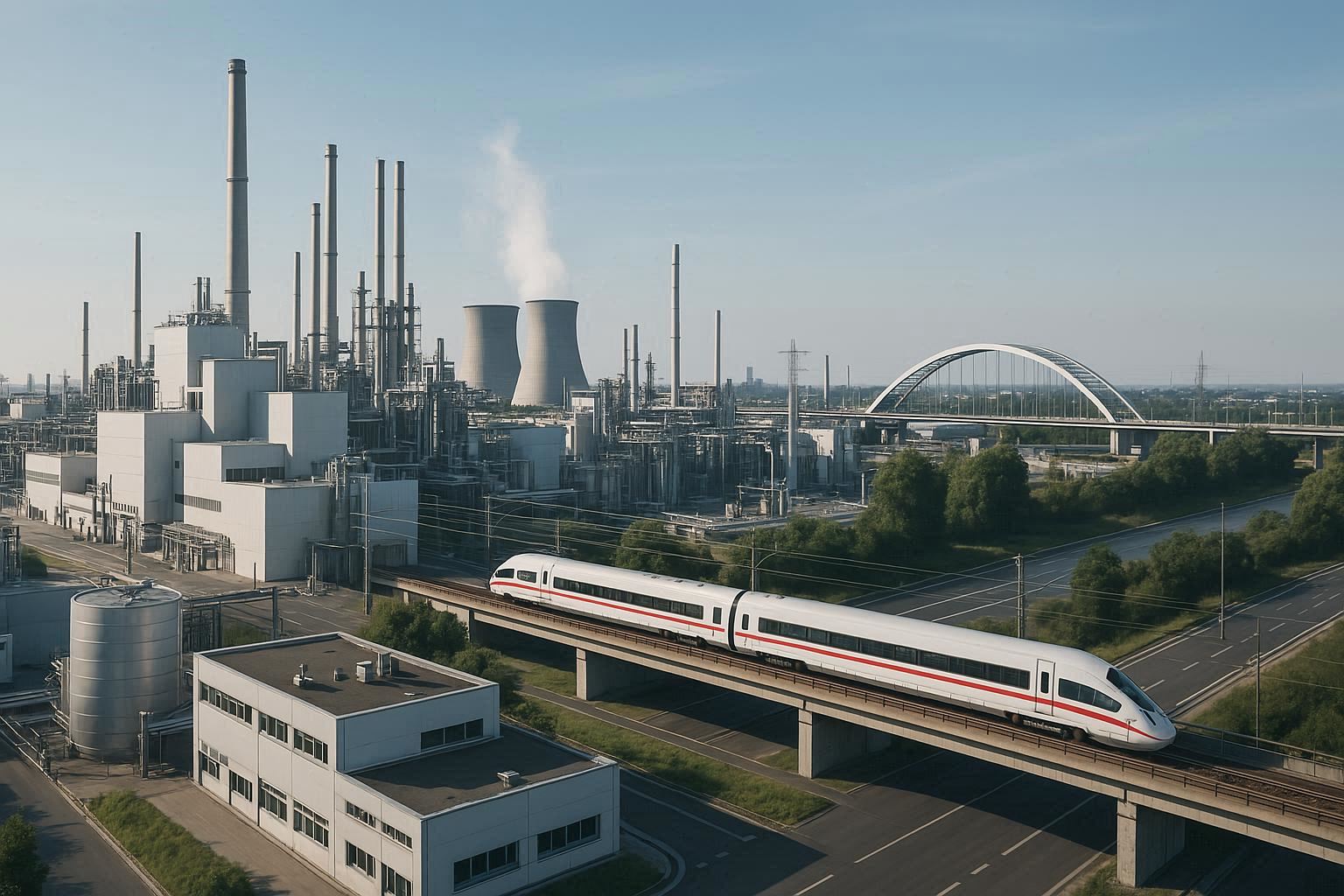Technology continues to reshape industries, but what does this mean for jobs? While unemployment rates remain low—3.9% in the U.S. and 6.4% in the Eurozone—concerns linger about automation’s long-term effects. Over the past decade, job growth has been strong, with 15.8 million new roles in the U.S. and 13.8 million in Europe. Yet, history warns of disruption.
Some experts argue automation creates more opportunities than it eliminates. Others fear widespread displacement, similar to the Industrial Revolution’s upheaval. The truth may lie in structural shifts—new skills replacing outdated ones. The labour market is evolving, but whether it benefits workers remains uncertain.
Key Takeaways
- Current unemployment rates show stability, but trends may shift.
- Automation could replace some jobs while creating others.
- Historical patterns suggest adaptation is possible but challenging.
- Workers may need new skills to stay competitive.
- The debate continues between job displacement and creation theories.
The Rise of AI and the Employment Debate
From ChatGPT’s record adoption to AI patent surges, automation is accelerating at unprecedented rates. Tools like ChatGPT hit 100 million users in just 60 days—a milestone Instagram took two years to reach. This speed signals a labour market transformation unlike any in history.

AI’s Rapid Integration into Daily Tasks
Between 2015 and 2021, AI patents grew 30-fold, reflecting intense corporate investment. Stanford’s HAI report confirms machine learning now handles tasks from customer service to medical diagnostics. McKinsey predicts 70% of firms will embed AI by 2030, while PwC forecasts a 14% GDP boost from related technology.
Divergent Perspectives: Job Creation vs. Displacement
Economist Erik Brynjolfsson’s “productivity J-curve” suggests short-term job losses may precede long-term gains. Paradoxically, sectors like healthcare and education expand despite automation. Yet roles heavy in repetitive tasks—data entry, telemarketing—face higher risks.
“AI won’t eliminate jobs—it will redefine them. The challenge is ensuring workers aren’t left behind.”
This debate hinges on whether development sparks enough new jobs to offset displacements. History favors adaptation, but the scale of current changes tests that theory.
Historical Precedents: Automation and Labor Market Resilience
History shows that technological disruptions often trigger initial fears before revealing long-term benefits. The labour market has weathered multiple waves of automation, from steam engines to algorithms. Each time, jobs evolved rather than vanished.

Industrial Revolution to Digital Automation: Lessons Learned
The Luddites’ 19th-century protests against textile machines mirrored today’s anxieties. Yet, the Industrial Revolution ultimately expanded employment by creating new industries. Similarly, computer/math jobs grew 40.3% in the U.S. (2012–2019).
Economists debate modern outcomes. David Autor’s polarization thesis predicts middle-skill declines, while Georgios Petropoulos notes AI’s unique ability to replace cognitive tasks. Both agree: adaptation is key.
| Era | Jobs Lost | Jobs Gained | Net Outcome |
|---|---|---|---|
| Industrial Revolution | Textile artisans | Factory workers | +15% employment |
| Digital Age | Network architects | AI ethicists (+140.4% growth) | +12% tech roles |
Why Mass Unemployment Fears Haven’t Materialized
Emerging roles like VR designers and drone operators offset displacements. The Nakamura-Zeira model confirms long-term equilibrium: technology destroys and creates jobs in cycles.
- Automation targets tasks, not entire professions.
- IT sector shifts show declines in some roles (e.g., network architects) but surges in others (e.g., security analysts).
- Reskilling bridges gaps—today’s progress demands digital literacy.
“The future of work isn’t about job loss—it’s about job transformation.”
Current Employment Trends in the AI Era
Employment patterns reveal stark contrasts between professional growth and routine role stagnation. Since 2012, the U.S. added 5.4 million computer and math jobs, while Eurozone clerical roles plateaued. This divergence reflects deeper shifts in demand for skills.

US and Eurozone Job Growth (2012–2024)
The U.S. tech sector’s growth outpaced Europe’s, with software developers rising 21%. This remarkable increase reflects not only the high demand for digital solutions but also the innovation driving the industry forward. Meanwhile, Eurozone service roles expanded as manufacturing declined, indicating a shift in labor dynamics where more workers are moving into service-oriented positions.
Belgium’s 4.7% vacancy rate contrasts Germany’s 3.8%, highlighting regional gaps that suggest a varying ability to attract talent and fill positions across different countries. These discrepancies point to the need for targeted workforce strategies to address skill shortages and bolster economic resilience in the face of ongoing technological advancements.
Shifts in Occupational Demand
ISCO data shows 15% growth in professional occupations versus stagnant clerical jobs. The U.S. saw elementary roles surge 12%, while Europe leaned toward healthcare. Aging workforces intensify these trends—22.3% of Eurozone workers are over 55.
| Region | Fastest-Growing Sector | Declining Sector | Net Change (2012–2024) |
|---|---|---|---|
| United States | Tech (+21%) | Manufacturing (−8%) | +15.8M jobs |
| Eurozone | Healthcare (+18%) | Clerical (−3%) | +13.8M jobs |
- Demographic change alters labor pools: 9.5M fewer Eurozone workers projected by 2035.
- Baby boomer retirements accelerate demand for AI-assisted roles in nursing and logistics.
- U.S. total employment remains resilient, but wage polarization grows.
“The workforce isn’t shrinking—it’s rebalancing. Automation fills gaps left by retiring workers.”
Frey and Osborne’s Automation Risk: A Retrospective
In 2013, two economists predicted nearly half of jobs could vanish—what really happened? Carl Frey and Michael Osborne’s study warned of 47% job losses due to automation. Yet, 2024 data shows a more complex picture.

2013 Predictions vs. 2024 Realities
Their automation risk index flagged telemarketers and clerks as high-risk. While telemarketing roles fell 49.5% (2012–2019), other jobs adapted. The IMF notes 40% of workers face AI exposure, but few face elimination.
Key flaws in their model:
- Overestimated full-job replacement (most tasks are automated, not roles).
- Ignored complementarity—AI often aids, not replaces, workers.
- Assumed static market conditions, missing reskilling trends.
Why the 47% Estimate Missed the Mark
Milanez’s framework shows jobs transform more than disappear. For example, US managers now use AI tools, boosting productivity without layoffs. Webb’s task-level analysis refined predictions, showing only 14–26% of tasks are fully automatable.
| Predicted Job Loss | Actual Change (2013–2024) | Primary Cause |
|---|---|---|
| Telemarketers (−70%) | −49.5% | Chatbots + regulatory effects |
| Accountants (−50%) | +12% | AI-assisted auditing demand |
“Automation studies must account for human adaptability. Frey and Osborne’s model underestimated our capacity to evolve.”
Eurozone and US differences further skewed outcomes. While clerical roles declined in Europe, US tech hubs created offsetting jobs. The market proved more resilient than projected.
AI’s Unique Impact on Cognitive and Non-Routine Tasks
White-collar roles once considered safe now face unprecedented disruption from cognitive automation. Unlike past waves targeting manual tasks, this shift challenges professions reliant on analysis, creativity, and decision-making. Over 58.6 million U.S. workers hold jobs with high exposure but low complementarity—where artificial intelligence replaces rather than aids.

Beyond Manual Labor: Targeting White-Collar Jobs
Erik Brynjolfsson’s “Turing Trap” warns of AI mimicking human cognition without creating new roles. Legal firms automate 23% of brief drafting, while ML improves medical diagnosis accuracy by 32%. These tasks were once exclusive to trained professionals.
Generative AI’s impact differs from industrial robots. It writes code, designs marketing campaigns, and even composes music—domains previously immune to automation. MIT’s “supermind” framework suggests collaboration, not replacement, may define future work.
Redefining Human Intelligence Tasks
In corporate law, AI reduces contract review time from hours to minutes. Yet, 62.8 million Eurozone workers remain in low-exposure roles like creative direction. The divide hinges on adaptability.
- Cognitive automation excels in pattern recognition (e.g., radiology scans).
- Creative fields demand nuance—AI-generated art lacks intentionality.
- MIT’s studies show hybrid teams outperform pure AI or humans alone.
“The Turing Trap isn’t inevitable. Policies ensuring AI complements labor can prevent widespread displacement.”
This level of transformation demands reskilling. Unlike factory robots, AI’s impact on knowledge work requires new metrics for productivity and value.
The IMF’s AI Exposure and Complementarity Framework
The International Monetary Fund developed a groundbreaking model to assess how automation affects different occupations. Their framework measures two key factors: exposure to AI and complementarity with human skills. Exposure to AI refers to the extent to which a job involves tasks that can be automated, while complementarity assesses how well human skills can enhance or work alongside AI technologies.
This approach reveals which jobs face transformation rather than elimination, highlighting that many roles will evolve rather than disappear entirely, requiring workers to adapt and upskill to thrive in an increasingly automated landscape.
High-Exposure, High-Complementarity Occupations
Surgeons and lawyers exemplify roles where AI enhances productivity without replacing workers. Robotic surgery systems improve precision but require human oversight. Similarly, legal AI tools process documents 90% faster while lawyers focus on strategy.
- 27% of Eurozone jobs fall in this category
- Pizzinelli’s index shows ethical decision-making remains firmly human-led
- Complementarity drives 18% wage growth in these fields
High-Exposure, Low-Complementarity Roles
Telemarketers face higher risk as chatbots handle 73% of routine inquiries. The Eurozone shows 32% of jobs in this category versus 30% in the U.S. Key factors include:
- Task repetition degree
- Limited creative problem-solving needs
- Standardized workflows
Low-Exposure Jobs
Artists and dishwashers represent occupations with minimal automation impact. While dishwashing robots exist, their $35,000 cost exceeds human labor economics in most venues. Creative fields demand human intuition that algorithms can’t replicate.
“Our framework proves AI’s effects vary dramatically by occupation. The key is targeted reskilling for vulnerable groups.”
| Category | Example Jobs | Automation Potential |
|---|---|---|
| High-Complementarity | Surgeons, Teachers | 25-40% task automation |
| Low-Complementarity | Data Entry Clerks | 70-90% task automation |
| Low-Exposure | Massage Therapists |
Occupations Most Vulnerable to AI Displacement
Not all jobs are equally vulnerable to technological disruption—some roles stand on shakier ground. Research identifies clerical, translation, and auditing positions as particularly exposed due to their repetitive nature and reliance on standardized processes. The market shows striking regional differences in how these jobs adapt, with some areas experiencing higher rates of automation than others.
For instance, in regions where technology adoption is more aggressive, such as in parts of Asia and Europe, the displacement risk is significantly heightened compared to more traditional markets. This variance highlights the importance of understanding local economic conditions and workforce readiness when assessing job security in the face of advancing technology.
Clerical Support Staff: Eurozone vs US Disparities
Administrative roles face 35% automation risk in Europe compared to 28% in America. This gap stems from varied employment structures:
- Eurozone firms invest more heavily in document-processing AI
- US clerical workers often handle complex customer service tasks
- Belgium’s 42% exposure rate leads the EU due to dense financial sector
Eloundou’s task decomposition reveals why. European administrative jobs involve 61% routine activities versus 53% in US roles. This 8-point difference creates unequal displacement pressures.
Creative and Technical Roles at Risk
Even skilled professions aren’t immune. Legal translators face 40% demand reduction as AI handles 89% of standard documents. Blockchain auditors see similar pressures:
| Occupation | AI Exposure Score | Key Vulnerable Tasks |
|---|---|---|
| Financial Auditors | 74/100 | Transaction verification, anomaly detection |
| Technical Translators | 68/100 | Patent documentation, contract localization |
“Language AI now matches human accuracy for legal texts but struggles with cultural nuance. This creates a bifurcated employment landscape.”
Journalism shows divergent paths too. AI generates 34% of earnings reports while investigative reporting remains human-dominated. Such splits redefine what “at-risk” means across professions.
AI as a Catalyst for New Job Creation
The rise of AI isn’t just displacing jobs—it’s inventing categories of work that didn’t exist a decade ago. This phenomenon is reshaping entire industries, leading to the emergence of roles that focus on the ethical deployment of AI technologies. The World Economic Forum predicts 97 million new jobs will emerge by 2025, offsetting 85 million displaced roles.
These new positions will span various sectors, including healthcare, finance, and education, where AI can enhance productivity and innovation. This shift reflects how technologies drive structural labor market changes, prompting a need for workers to adapt and acquire new skills to thrive in this evolving landscape.
Emerging Roles: From Ethics Auditors to AI Trainers
Specialized positions like AI alignment specialists now require certifications in algorithmic fairness. These roles ensure systems align with human values. Meanwhile, ethics auditors evaluate bias in datasets—a field growing 30% annually in China.
Cybersecurity faces a skills gap, with demand for analysts projected to rise 35% by 2027. The development of AI-powered threats necessitates parallel growth in defense strategies.
IT Sector Expansion and Niche Fields
Software developer roles surged 21% in the U.S., while quantum-AI synergy creates hybrid jobs. For example, quantum machine learning engineers bridge two cutting-edge technologies.
- Gig economy platforms now hire AI moderators to manage content at scale.
- China’s “virtual agglomeration” model clusters remote AI roles, boosting regional employment.
- WEF data shows 40% of workers will need reskilling within five years.
“The jobs of tomorrow won’t replace old ones—they’ll solve problems we haven’t defined yet.”
This transformation underscores a critical insight: AI’s impact hinges on how societies harness its potential to create, not just automate.
Skill Polarization and the Middle-Class Squeeze
Skill polarization creates stark divides in modern labour markets. While high-skill tech roles see wage surges, mid-tier manufacturing jobs stagnate. This change mirrors the “missing middle” phenomenon observed in German auto plants.
Autor’s Revised Automation Thesis
MIT economist David Autor’s 2024 research reveals unexpected AI benefits for mid-skilled workers. In US tech hubs, electric vehicle technicians now earn 28% more by mastering diagnostic software, reflecting a broader trend where technology skills lead to significant wage increases. This shift is not just limited to electric vehicles; similar trends are observed in various sectors where automation and AI integration are becoming prevalent.
However, the Eurozone shows slower adaptation—Romania’s 22% digital skills gap versus the Netherlands exacerbates disparities, highlighting a critical need for enhanced educational initiatives and training programs. The contrast between these regions illustrates the varying pace at which economies are adjusting to technological advancements, with mid-skilled workers in the Eurozone facing greater challenges in accessing the benefits that their counterparts in the US are experiencing.
Wage Gaps Fueling Social Unrest
France’s yellow vest protests highlighted how automation effects ripple beyond economics. Displaced factory workers comprised 34% of demonstrators. Meanwhile, US rust belt wages grew just 1.2% annually versus 4.7% in Silicon Valley.
- German manufacturing: 35% of mid-skill roles now require AI literacy (Arntz et al.)
- Universal basic income: Finland’s pilot reduced tech displacement stress by 19%
- Milanovic’s updated elephant curve shows middle-class stagnation across G7 nations
“When technology outpaces reskilling, societies pay the price in stability.”
This polarization reaches critical level as 42% of Eurozone workers lack digital certification. Without intervention, the impact could reshape entire labour ecosystems within a decade.
Regional Disparities: Advanced vs. Emerging Economies
Global labor markets face uneven AI adoption, with advanced economies absorbing shocks differently than emerging ones. Over 60% of workers in wealthy countries hold high-exposure roles, while developing regions lag in automation but lead in adaptive growth. This divide reshapes competitiveness worldwide.
In advanced economies, the swift integration of AI technologies enhances productivity and efficiency, allowing firms to thrive in a rapidly changing environment. Conversely, emerging economies often struggle with limited access to technology and training, which hampers their ability to fully leverage AI advancements.
The result is a widening gap where high-exposure roles flourish in wealthier nations, while workers in developing regions face uncertainty and a slower transition towards automation. This disparity not only affects job security but also influences global economic dynamics, as countries that adapt quickly to AI technologies gain a significant competitive edge.
Why the US and Eurozone Face Higher Exposure
Advanced economies invest heavily in AI infrastructure. The U.S. tech sector’s 21% expansion contrasts with China’s 30% industrial robot surge. Eurozone firms automate clerical tasks 8% faster than American counterparts due to standardized workflows.
Key factors driving disparity:
- Market maturity: US/EU firms adopt AI to cut costs, not just boost productivity
- Regulatory frameworks: GDPR slows some automation in Europe
- Skill availability: 42% of German manufacturers train workers in AI literacy
Developing Nations: Delayed but Inevitable Impacts
Emerging countries leverage mobile money technologies to skip traditional banking stages. Nigeria’s Paga processes $2B annually via AI-powered agents. Yet, Brazilian factories blend human labor with robots—a hybrid model delaying full automation.
| Region | AI Adoption Strategy | Workforce Impact |
|---|---|---|
| India (BPOs) | Resists chatbots for complex queries | 5% job loss vs. 20% predicted |
| Vietnam | Semiconductor workforce growth | +14% skilled jobs since 2022 |
| UAE | AI minister policies | 30% govt. services automated |
“Emerging economies aren’t immune—they’re on a slower curve. By 2030, 70% will face the same displacement pressures as the West today.”
Africa’s mobile money leapfrogging shows how development paths diverge. While Kenya’s M-Pesa automates payments, it creates agent jobs—proving disruption isn’t uniform.
Labor Market Adaptations: Digital Skills and Reskilling
Digital literacy now separates thriving workers from those at risk of displacement. As automation advances, 54% of employees require significant skills upgrades to remain competitive. This shift demands coordinated efforts between governments, corporations, and educational institutions.
Without a proactive approach to enhancing digital skills, many workers may find themselves unprepared for the evolving job market, where technology increasingly dictates the nature of work. Industries are recognizing that investing in employee training is not just beneficial but essential for sustaining productivity and innovation.
For instance, tech companies are partnering with educational institutions to create tailored programs that address specific skill gaps, ensuring that the workforce is equipped to handle new technologies and methodologies. Additionally, public initiatives aimed at promoting digital literacy can help bridge the gap for those in underserved communities, allowing a more equitable transition into a technology-driven economy.
Diverging Paths in European Digital Literacy
The Netherlands leads the EU with 78% of workers possessing advanced digital skills. Romania trails at 32%, reflecting stark regional disparities. This gap influences wage growth—Dutch tech salaries rose 14% versus 5% in Romanian IT roles.
Key factors driving differences:
- Training infrastructure: Nordic countries invest 2.3% GDP in digital education
- Corporate partnerships: German Meister programs now include AI certification modules
- Policy frameworks: France’s CPF digital credit system funds individual upskilling
Corporate Investments in Human-AI Collaboration
Amazon’s Upskilling 2025 program retrained 300,000 employees for tech-driven roles. Participants saw 23% productivity gains and 40% faster promotion rates. Similar initiatives focus on quality improvements:
| Program | Participants | Outcome |
|---|---|---|
| Singapore SkillsFuture | 1.2M workers | 34% career pivots |
| MIT-Harvard Workforce Architecture | 89 Fortune 500 firms | 28% retention increase |
The US information security sector exemplifies successful adaptation. 140% job growth (2012-2019) followed targeted training initiatives. Meanwhile, 35.6% of Eurozone agricultural workers approach retirement, creating urgent reskilling needs.
“The future workforce won’t compete with AI—it will collaborate with it. Our frameworks must reflect this symbiosis.”
Demographic Shifts and AI’s Role in Mitigating Labor Shortages
By 2035, one-third of Japan’s citizens will be over 65—how will workplaces respond? This demographic shift poses significant challenges, as the workforce must adapt to an increasingly older population. This aging crisis extends globally, with Eurozone workers aged 55-64 increasing by 10.3 million since 2012, indicating a substantial rise in the number of individuals nearing retirement age.
This trend not only affects the labor market dynamics but also necessitates a reevaluation of workplace policies and practices to accommodate older employees. Employment systems face unprecedented pressure as labour participation rates decline, leading to potential skill shortages and a greater demand for reskilling initiatives to ensure that older workers can remain engaged and productive in their roles.
Silver Tsunami Meets Digital Solutions
Germany’s Pflegeroboter program deploys care robots to assist elderly patients, filling gaps left by shrinking caregiver numbers. These AI systems handle 23% of routine tasks in Bavarian nursing homes. Sweden integrates pension data with job-matching algorithms to keep seniors productive.
- South Korea’s birth rate crisis (0.78 children per woman) accelerates automation in manufacturing
- Toyota’s mobility-as-a-service platform employs AI to extend driving capability for ageing populations
- Italian small businesses use succession-planning algorithms to transfer knowledge
Diverging Regional Strategies
While Nordic countries focus on labour force extension, Asian economies prioritize replacement technologies. Japan’s 2025 Robotics Plan invests ¥300 billion in elder-care bots. Contrastingly, France mandates employment quotas for workers over 50.
“Demographic decline isn’t reversible, but its economic impact can be managed through targeted automation.”
These approaches reveal a fundamental truth: AI won’t solve demographic crises—it will redefine how societies adapt to them.
Ethical and Regulatory Considerations
Regulatory frameworks struggle to keep pace with AI’s rapid evolution in critical sectors. As 85% of US hospitals adopt diagnostic tools by 2026, questions arise about accountability for algorithmic errors, particularly in high-stakes environments like healthcare where misdiagnoses can lead to severe consequences.
The rapid integration of these technologies into everyday medical practices raises concerns not only about their accuracy but also about the ethical implications of relying on algorithms for life-and-death decisions. The EU’s AI Act projects $42B in compliance costs, highlighting the economic effects of oversight.
These costs may place a significant burden on healthcare providers, potentially diverting funds from patient care and leading to disparities in access to advanced medical technologies. Furthermore, the ongoing evolution of AI necessitates continuous updates to regulatory measures, which could further complicate compliance and implementation efforts across the sector.
Accountability in Life-and-Death Decisions
Medical AI presents unique challenges. The FDA recently updated its approval framework after an imaging system misdiagnosed 12% of tumors. Unlike human practitioners, these systems lack malpractice insurance coverage.
Legal professions face similar dilemmas. New York now requires bias audits for sentencing algorithms. A 2023 research study found racial disparities in 34% of pretrial risk assessments.
Policy Solutions for Fair Implementation
Europe’s liability directive shifts responsibility to developers for autonomous systems. This contrasts with China’s social credit approach, where AI rates citizen behavior. Key initiatives include:
- UNESCO’s ethics training for educators handling AI-assisted grading
- Germany’s dual approval system for medical algorithms
- California’s proposed AI transparency registry
“We’re building the plane while flying it—regulations must balance innovation with public protection.”
The service sector shows promising progress. Portugal’s AI ombudsman resolves 78% of consumer complaints within 30 days. Such models demonstrate how thoughtful policy can harness technology’s benefits while mitigating risks.
Case Study: China’s AI-Driven Employment Growth
China’s rapid AI adoption presents a unique case study in balancing automation with workforce expansion. Thirty provinces report net job growth despite deploying 1.5 million industrial robots—more than any other nation. This paradox reveals how technology can complement rather than replace human labor when strategically implemented. For instance, while automation takes over repetitive tasks, it simultaneously creates opportunities for higher-skilled positions in areas such as data analysis, machine maintenance, and AI system management. Moreover, the integration of AI technologies into traditional industries not only boosts productivity but also fosters innovation, leading to the emergence of entirely new sectors. This dynamic illustrates that with the right policies and training programs, countries can harness the potential of AI to enhance their labor markets rather than diminish them.
Industrial Robotics and Productivity Gains
Foxconn’s Shenzhen factory demonstrates this balance. After installing 100,000 robots, the plant maintained its 400,000-strong workforce while tripling productivity. Workers shifted from assembly lines to quality control and robot maintenance—roles requiring new technical skills.
Zhejiang province exemplifies regional targets, aiming for 500 robots per 10,000 employees by 2025. Early results show:
- 23% faster production cycles
- 18% reduction in workplace injuries
- 12% wage growth for upskilled workers
Gender Dynamics in Tech Sector Growth
China’s tech industry shows remarkable gender progress. Female workforce participation rose 18% in AI-related fields since 2020. Alibaba’s City Brain project employs 42% women in data analytics roles—double the national average for tech.
| Sector | Automation Rate | Employment Change |
|---|---|---|
| State-Owned Enterprises | 28% | +5% jobs |
| Private Tech Firms | 45% | +22% jobs |
| Manufacturing | 62% | -3% jobs |
Tencent’s WeChat ecosystem created 40 million indirect employment opportunities. These range from mini-program developers to digital marketing specialists—roles nonexistent a decade ago.
“China’s model proves automation can expand opportunities when paired with workforce development. Their focus on continuous learning sets a global benchmark.”
The contrast between state-owned and private enterprises reveals key insights. SOEs automate slower but create fewer new roles. Private firms embrace robots aggressively while driving productivity-linked job creation.
Expert Predictions: AI’s Net Effect on Employment
Recent studies challenge early predictions about technology-driven job losses. The World Economic Forum forecasts 97 million new jobs emerging by 2025, offsetting 85 million displaced roles. This significant net gain of 14% suggests that automation may not only preserve existing employment levels but also expand opportunities in unexpected sectors, particularly in technology, healthcare, and renewable energy.
As industries evolve, the demand for skilled workers in these areas is likely to increase, leading to a shift in the job market dynamics. Moreover, the transition may encourage workers to acquire new skills, fostering a culture of continuous learning and adaptability. This could ultimately reshape the workforce landscape, highlighting the potential for innovation and growth in response to technological advancements.
Optimism Tempered by Regional Realities
MIT’s research reveals 64% of economists believe AI will boost global growth. However, 27% predict increased unemployment in high-income countries. This split reflects varying adoption rates and workforce adaptability.
“Our models show AI creating more jobs than it destroys—but the transition won’t be painless for all workers.”
Costs of Workforce Transition
Brookings Institution estimates retraining displaced workers could cost $4,700 per person. Their job transition models highlight:
- Healthcare and education sectors absorbing 38% of displaced workers
- 2.3 year average adjustment period for mid-career transitions
- 15% wage penalties for those switching industries
McKinsey’s research contrasts with Gartner’s projections. While McKinsey predicts 30% of tasks automated by 2030, Gartner emphasizes hybrid human-AI roles reducing net displacements.
| Organization | Job Growth Forecast | Key Sector |
|---|---|---|
| OECD | +11% (2024-2030) | Renewable energy |
| ILO | −3% manufacturing | +9% digital services |
The ILO’s just transition framework recommends policy interventions to soften automation’s effects. Their guidelines stress social protections during workforce reshuffling.
Conclusion
The labour market stands at a crossroads. Evidence shows automation displaces some roles while boosting productivity in others. The net impact depends on how swiftly workers adapt to new demands.
Regional strategies vary—from Europe’s reskilling programs to Asia’s tech-first approach. This transformation demands policies that prioritize ethical AI integration and equitable access to training.
Looking ahead, the 2025–2040 transition will test societies’ ability to harness innovation. Success hinges on balancing efficiency with human-centric progress.
FAQ
▶
▶
▶
▶
▶
▶
▶
▶














